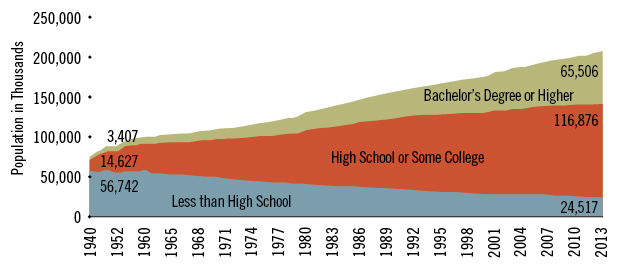Ask An Economist
Guillaume Vandenbroucke is a senior economist at the Federal Reserve Bank of St. Louis, where he has worked since mid-2014. His research focuses on human capital and schooling, as well as on demographic questions related to such topics as fertility and marriage. He enjoys reading, swimming and spending time with his family.
For more on his research, see http://research.stlouisfed.org/econ/vandenbroucke.
Q. How much education do Americans get?
How has this figure changed over time?
A.These are important questions. Education is a primary determinant of an individual’s lifetime earnings. At a macroeconomic level, understanding the evolution of educational attainment is relevant, given the importance of human capital to the national income of countries.
On average, Americans spend about 14 years in school. Educational attainment has increased remarkably since early in the 20th century, as can be seen in the chart. In 1940, 76 percent of those 25 and older had not completed high school; by 2013, only 12 percent hadn’t.
Diego Restuccia at the University of Toronto and I have a paper in which we asked what caused this substantial trend.1 We developed a model in which individuals can accumulate human capital (i.e., become educated) and assessed how much technological progress and changes in life expectancy contributed to the increase of educational attainment. We found that skill-biased technical change represented the most important factor in accounting for the increase in educational attainment. In other words, the main reason why more people sought education was because technology keeps rewarding educated people with better and better paychecks. This may sound obvious, but there are many other reasons for people to continue their education. Knowledge could be enjoyable, for instance. After all, even retired people sometimes go back to school to learn about something they are interested in. Yet, we are finding that the strongest of all reasons is that education simply is a good investment.
Population Age 25 and Over by Educational Attainment: 1940-2013
SOURCES: www.census.gov/hhes/socdemo/education/data/cps/historical/index.html and
www.oecdbetterlifeindex.org/topics/education.
Views expressed in Regional Economist are not necessarily those of the St. Louis Fed or Federal Reserve System.
For the latest insights from our economists and other St. Louis Fed experts, visit On the Economy and subscribe.
Email Us



